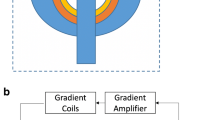Abstract
To evaluate the sensitivity of T2-weighted fast spin-echo (FSE) sequences to physiological iron depositions in normal brains at MR imaging field strengths of 1.5 and 3.0 T. T2-weighted FSE sequences acquired at 1.5 and 3.0 T clinical imaging systems (Gyroscan Intera, Philips Medical Systems, Best, The Netherlands) were compared by means of MRI in phantoms (n=6) and healthy volunteers (n=10). Contrast-to-noise ratios (CNRs) of tubes doped with iron oxides at different concentrations and of brain areas with physiological iron depositions (nucleus ruber, substantia nigra, globus pallidus) were calculated for either field strength. Apparent susceptibility effects of iron-containing brain structures were qualitatively analyzed by comparing the degree of visible hypointensity by a score system at either field strength. The mean CNR of iron oxide tubes and iron-containing brain areas was significantly decreased at 3.0 T. Qualitative analysis confirmed these measurements. Detection and diagnosis of brain disorders with altered iron content such as neurodegenerative parkinsonian disorders (NPD) or intracerebral hemorrhage should benefit from the increased sensitivity of T2-weighted FSE sequences to susceptibility effects at 3.0 T.


Similar content being viewed by others
References
Bradley WG Jr (1993) MR appearance of hemorrhage in the brain. Radiology 189:15–26
Braffman BH, Grossman RI, Goldberg HI et al (1989) MR imaging of Parkinson disease with spin-echo and gradient-echo sequences. Am J Roentgenol 152:159–165
Martin WR (2001) Magnetic resonance imaging and spectroscopy in Parkinson’s disease. Adv Neurol 86:197–203
Olanow CW (1992) Magnetic resonance imaging in parkinsonism. Neurol Clin 10:405–420
Ordidge RJ, Gorell JM, Deniau JC, Knight RA, Helpern JA (1994) Assessment of relative brain iron concentrations using T2-weighted and T2*-weighted MRI at 3 Tesla. Magn Reson Med 32:335–341
Rutledge JN, Hilal SK, Silver AJ, Defendini R, Fahn S (1987) Study of movement disorders and brain iron by MR. Am J Roentgenol 149:365–379
Jones KM, Mulkern RV, Schwartz RB et al (1992) Fast spin-echo MR imaging of the brain and spine: current concepts. Am J Roentgenol 158:1313–1320
Righini A, Antonini A, Ferrarini M et al (2002) Thin section MR study of the basal ganglia in the differential diagnosis between striatonigral degeneration and Parkinson disease. J Comput Assist Tomogr 26:266–271
Bhattacharya K, Saadia D, Eisenkraft B et al (2002) Brain magnetic resonance imaging in multiple-system atrophy and Parkinson disease: a diagnostic algorithm. Arch Neurol 59:835–842
Kraft E, Trenkwalder C, Auer DP (2002) T2*-weighted MRI differentiates multiple system atrophy from Parkinson’s disease. Neurology 59:1265–1267
Allkemper T, Reimer P, Schuierer G, Peters PE (1998) Study of susceptibility-induced artefacts in GRASE with different echo train length. Eur Radiol 8:834–838
Seidenwurm D, Meng TK, Kowalski H, Weinreb JC, Kricheff II (1989) Intracranial hemorrhagic lesions: evaluation with spin-echo and gradient-refocused MR imaging at 0.5 and 1.5 T. Radiology 172:189–194
Reimer P, Allkemper T, Schuierer G, Peters PE (1996) Brain imaging: reduced sensitivity of RARE-derived techniques to susceptibility effects. J Comput Assist Tomogr 20:201–205
Hennig J, Nauerth A, Friedburg H (1986) RARE imaging: a fast imaging method for clinical MR. Magn Reson Med 3:823–833
Jones KM, Mulkern RV, Mantello MT et al (1992) Brain hemorrhage: evaluation with fast spin-echo and conventional dual spin-echo images. Radiology 182:53–58
Schwindt W, Kugel H, Bachmann R et al (2003) Magnetic resonance imaging protocols for examination of the neurocranium at 3 T. Eur Radiol 13:2170–2179
Oehler MC, Schmalbrock P, Chakeres D, Kurucay S (1995) Magnetic susceptibility artifacts on high-resolution MR of the temporal bone. Am J Neuroradiol 16:1135–1143
Campeau NG, Huston J III, Bernstein MA, Lin C, Gibbs GF (2001) Magnetic resonance angiography at 3.0 Tesla: initial clinical experience. Top Magn Reson Imaging 12:183–204
Armitage P, Berry G (1987) Statistical methods in medical research, 2nd edn. Blackwell, Oxford
Low RN, Francis IR, Sigeti JS, Foo TK (1993) Abdominal MR imaging: comparison of T2-weighted fast and conventional spin-echo, and contrast-enhanced fast multiplanar spoiled gradient-recalled imaging. Radiology 186:803–811
Nghiem HV, Herfkens RJ, Francis IR et al (1992) The pelvis: T2-weighted fast spin-echo MR imaging. Radiology 185:213–217
Listerud J, Einstein S, Outwater EK, Kressel HY (1993) First principles of fast spin-echo. Magn Reson Q 8:199–244
Melki PS, Jolesz FA, Mulkern RV (1992) Partial RF echo-planar imaging with the FAISE method. II. Contrast equivalence with spin-echo sequences. Magn Reson Med 26:342–354
Melki PS, Jolesz FA, Mulkern RV (1992) Partial RF echo planar imaging with the FAISE method. I. Experimental and theoretical assessment of artifact. Magn Reson Med 26:328–341
Duguid JR, De La Paz R, DeGroot J (1986) Magnetic resonance imaging of the midbrain in Parkinson’s disease. Ann Neurol 20:744–747
Gelman N, Gorell JM, Barker PB et al (1999) MR imaging of human brain at 3.0 T: preliminary report on transverse relaxation rates and relation to estimated iron content. Radiology 210:759–767
Ma J, Wehrli FW (1996) Method for image-based measurement of the reversible and irreversible contribution to the transverse-relaxation rate. J Magn Reson B 111:61–69
O’Brien C, Sung JH, McGeachie RE, Lee MC (1990) Striatonigral degeneration: clinical, MRI, and pathologic correlation. Neurology 40:710–711
Kume A, Shiratori M, Takahashi A et al (1992) Hemi-parkinsonism in multiple system atrophy: a PET and MRI study. J Neurol Sci 110:37–45
Savoiardo M, Girotti F, Strada L, Ciceri E (1994) Magnetic resonance imaging in progressive supranuclear palsy and other parkinsonian disorders. J Neural Transm [Suppl] 42:93–110
Schrag A, Kingsley D, Phatouros C et al (1998) Clinical usefulness of magnetic resonance imaging in multiple system atrophy. J Neurol Neurosurg Psychiat 65:65–71
Author information
Authors and Affiliations
Corresponding author
Rights and permissions
About this article
Cite this article
Allkemper, T., Schwindt, W., Maintz, D. et al. Sensitivity of T2-weighted FSE sequences towards physiological iron depositions in normal brains at 1.5 and 3.0 T. Eur Radiol 14, 1000–1004 (2004). https://doi.org/10.1007/s00330-004-2241-4
Received:
Revised:
Accepted:
Published:
Issue Date:
DOI: https://doi.org/10.1007/s00330-004-2241-4




